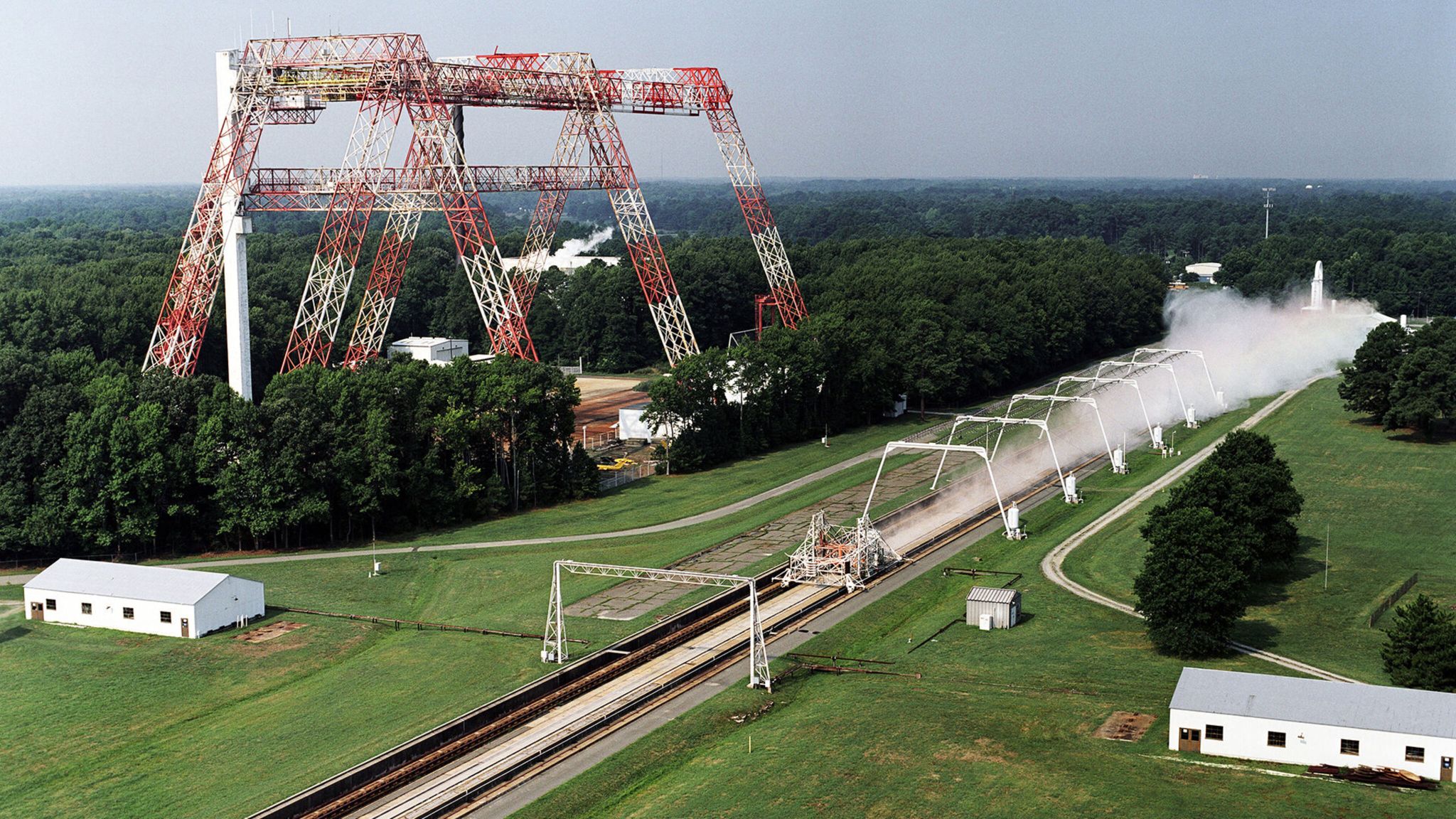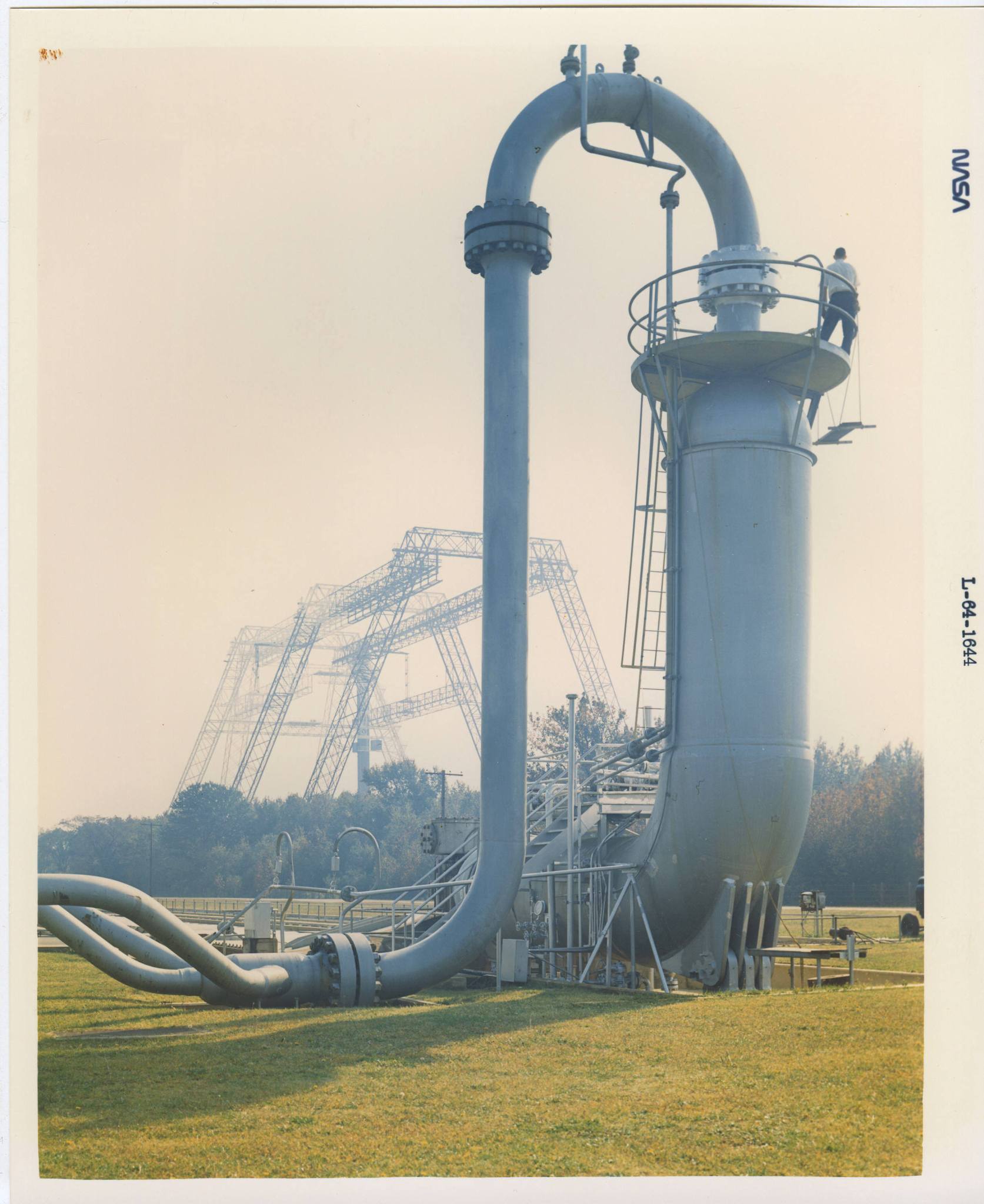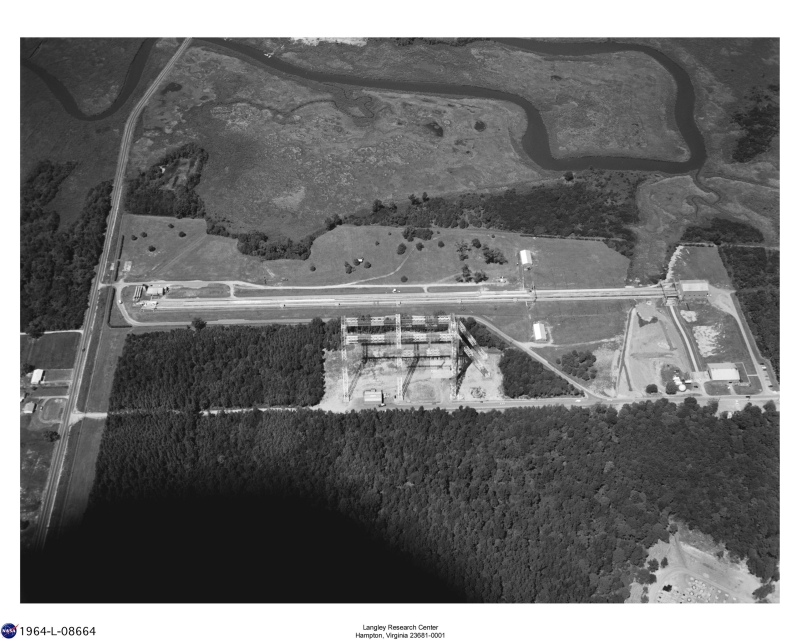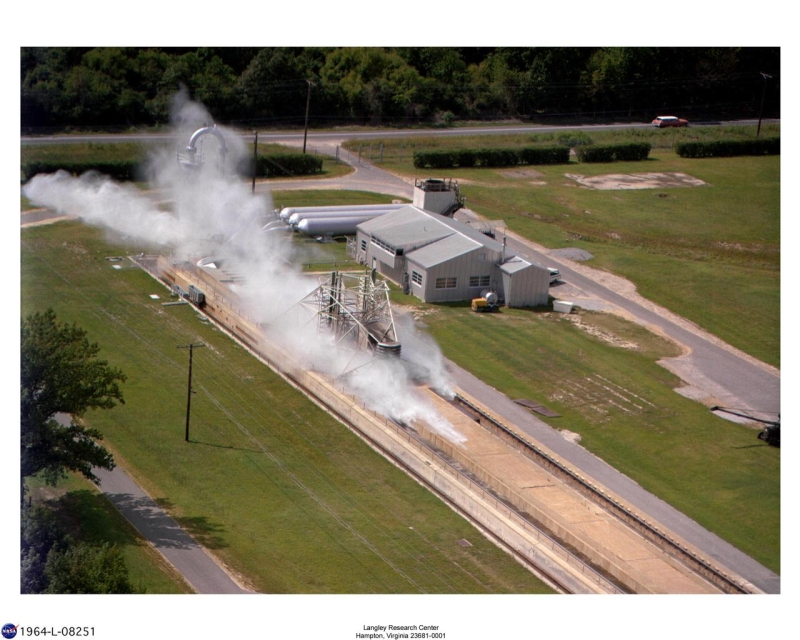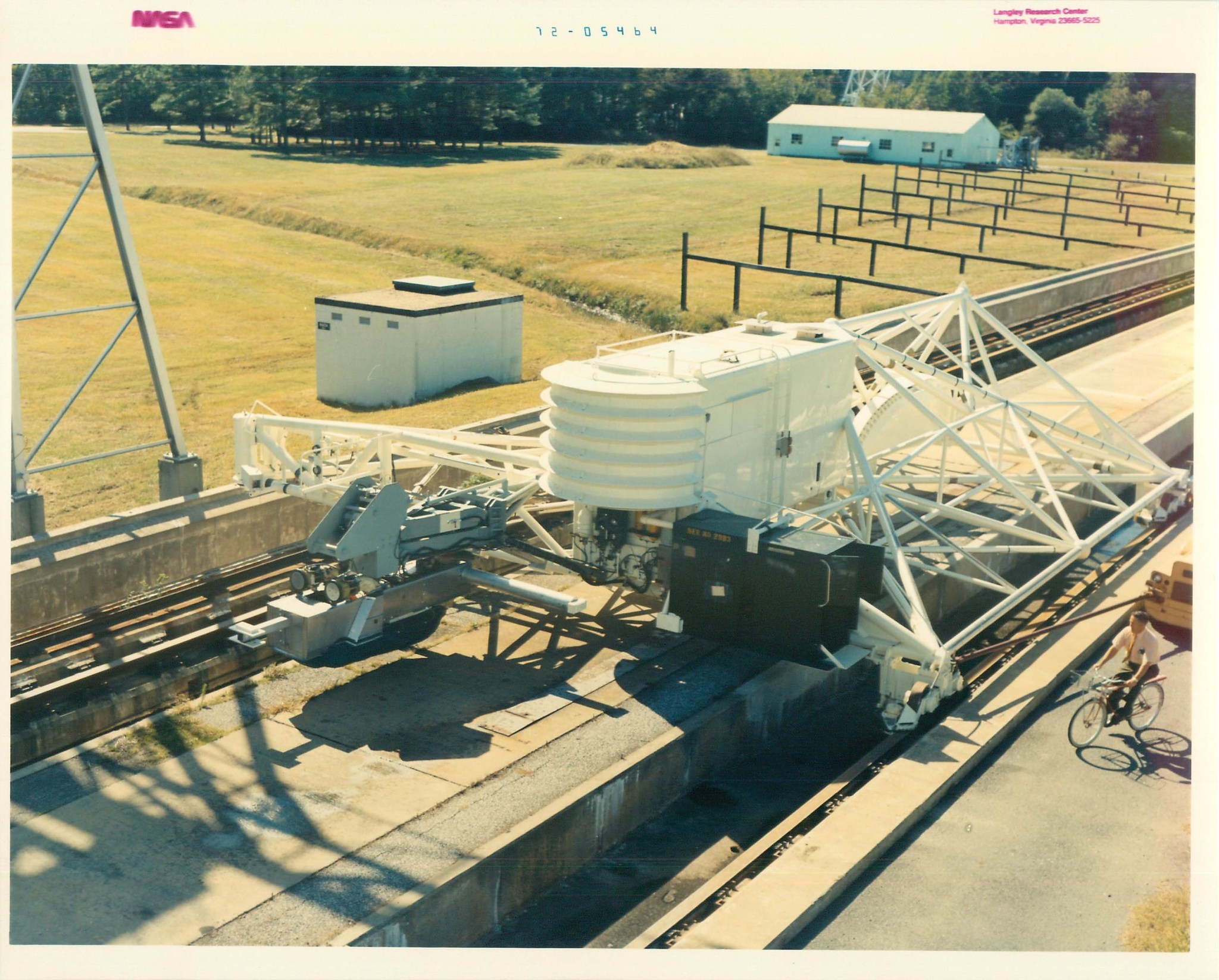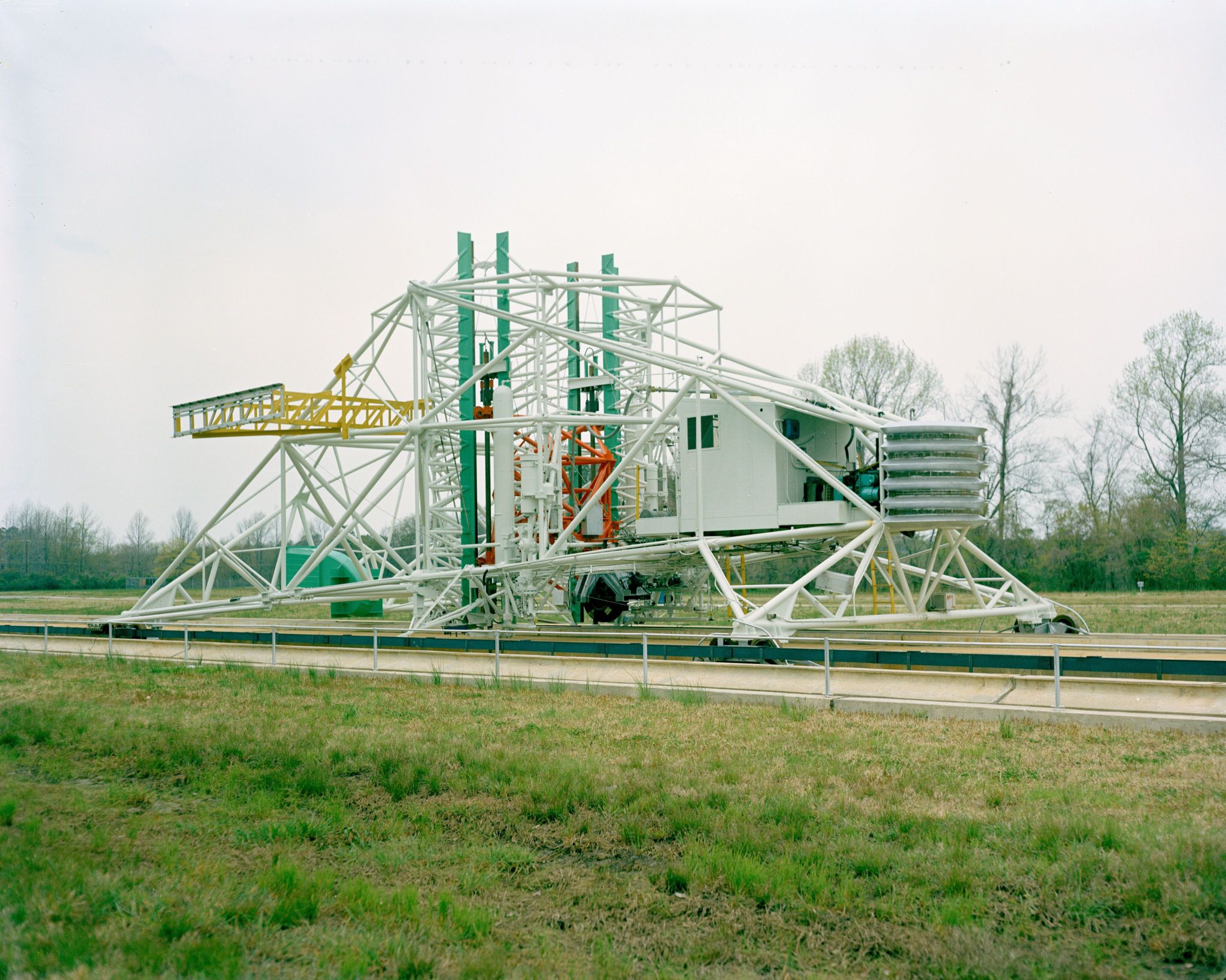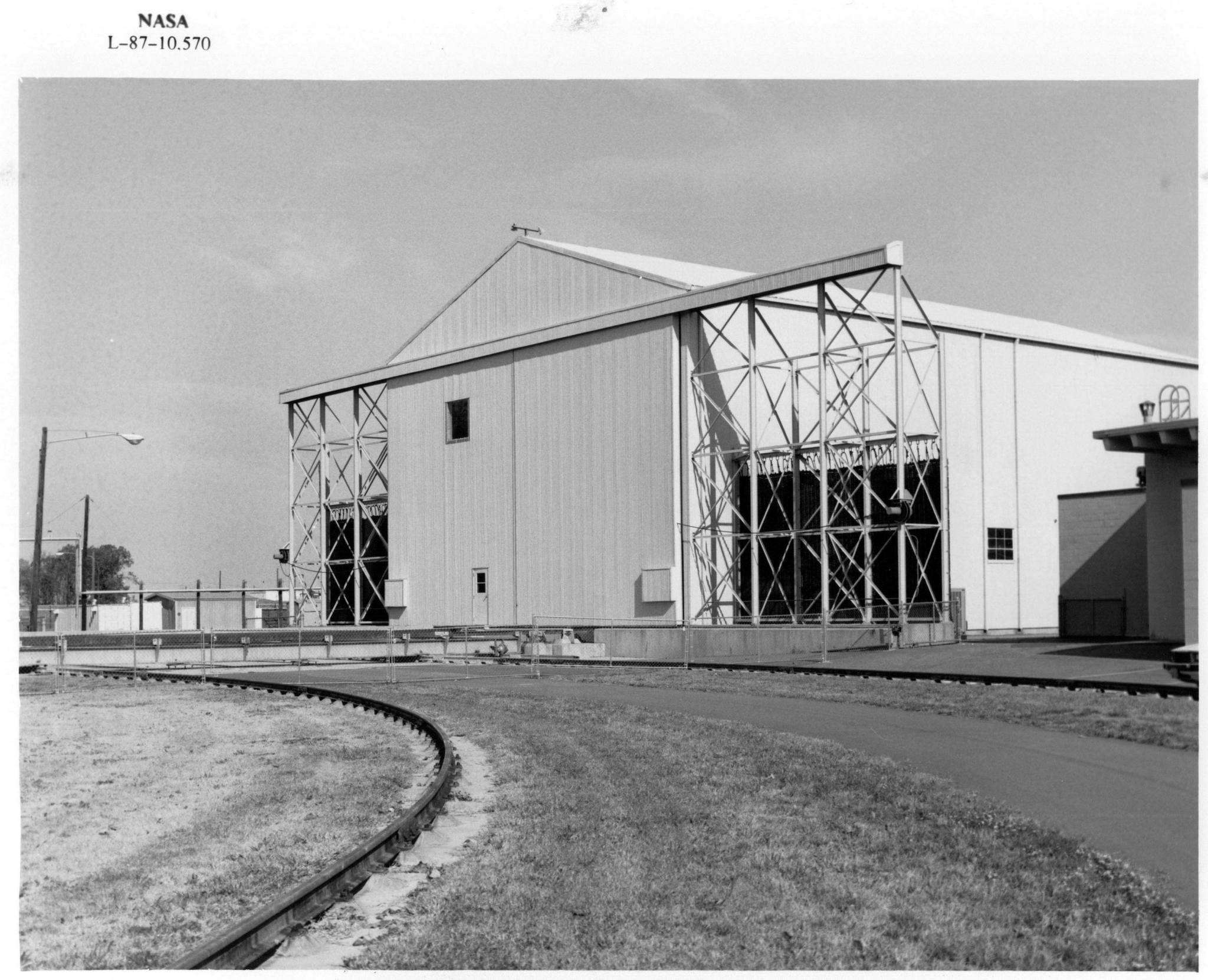Quick Facts
Year Built: 1953 to 1956
Historic Eligibility: National Register Eligible
Important Tests: Landing gear systems, runway surfaces, brake systems
History
One of the most challenging design issues for modern aerospace vehicles is providing a high degree of safety and efficiency during critical takeoff and landing operations, especially during extreme environmental conditions.
To address this, in the late 1940s the NACA studied various concepts to conduct research on landing gear systems during simulated runway landings. Langley proceeded to develop a landing track facility which immediately contributed to advancements in several key technology areas. In later years, the facility was upgraded to serve NASA’s and the nation’s needs in a wide variety of applications for aircraft and aerospace vehicles.
Research and technology studies of landing gear systems at Langley were centered at what became known as the Aircraft Landing Loads and Traction Facility Complex (ALDF), a unique track complex located in the NASA West Area.
Its original facilities were constructed between 1953 and 1956 and were comprised of: a Landing Loads Track (Building 1257); paved test strip (Building 1257A); north arresting gear (Building 1257N); south arresting gear (Building 1257S); landing loads track compressor building and control room (Building 1258); arresting gear housing facilities (Buildings 1259 and 1260); landing loads track shop and calibration facility (Building 1261); and office building (Building 1262).
Since becoming operational in the mid-1950s, these facilities resulted in world-wide recognition of Langley as a leader in research and technology for landing loads, landing gear systems, runway surfaces and adverse weather effects. Two research programs – pavement grooving and design standards for aircraft tires – had the maximum impact and benefit to the aircraft industry, spacecraft operations and the public. The facility provided what was arguably one of the most cost-effective products ever produced by the NASA technical program, the development of runway treatments, such as grooving, that minimized the hazard of tire hydroplaning.
Landing Loads Track
In the early 1950s, Langley’s Upshur T. Joyner led studies to develop a cost-effective catapult-type system for researching landing loads. These studies concluded that a high-pressure water-jet-powered concept was the most promising approach. The concept was implemented in 1956 as the Landing Loads Track (LLT).
The LLT included an L-shaped water vessel, compressed air storage tanks, a quick-opening valve and a reaction bucket on the rear of a test carriage, a tubular steel truss structure with a carriage. Landing gear test articles attached to the carriage could be lowered at specified rates to simulate different landing impacts. Five arresting-gear cables, attached to 20 energy absorbers, were used to dissipate the energy of the carriage at the end of the test run. The carriage rolled on steel rails spaced 30 feet apart on a track that was 2,000-feet long.
During tests, which would last for about seven seconds, the catapult system would propel the carriage for about 400 feet at a speed of 100 knots with a maximum g-force (acceleration) of 3.3. The carriage would then coast through a 1,200-foot test section where the test article was lowered onto runway surfaces of various textures and conditions before being stopped by an arresting-cable system.
Research activities at the LLT covered many critical technologies related to the landing-gear characteristics of aerospace vehicles. This included tires, skids, brakes, steering systems, air-cushion landing systems, cross-wind landing gear and various runway conditions.
The facility’s research also resulted in benefits enjoyed by the general public, such as improved tire performance and grooved roadways that improved traction, both contributing to dramatically improved highway safety.
Aircraft Landing Dynamics Facility
When the LLT was put into operation in 1956, its maximum speed of 110 knots was sufficient to cover the landing speeds of propeller-driven civil aircraft of the time. However, the rapid advances in size and weight of commercial and military aircraft in the 1960s resulted in landing speeds beyond the capabilities of the facility. Beginning in 1982, Langley upgraded and refurbished the LLT to test at speeds up to 220 knots, the maximum landing speed of NASA’s space shuttle orbiter.
To provide increased performance, a larger L-vessel system was installed along with a new test carriage to withstand the loads of the increased catapult thrust, upwards of 20 g-force. The overall track was extended to 2,800 feet and the test section was lengthened to 1,800 feet, resulting in longer test times at higher speeds. A new arresting gear system was installed to stop the carriage within 500 feet (with a maximum carriage deceleration of about 6 g-forces).
Test articles at the updated facility, now known as the Aircraft Landing Dynamics Facility (ALDF), could be subjected to vertical loads up to 65,000 pounds or sink rates up to 20 feet/second. Data acquisition was accomplished with onboard battery-powered instrumentation which could then send it via telemetry to an instrumentation room in the Command Center (Building 1258). High-speed motion picture records could also be made during the test run. Completing all of these upgrades took three years, and in the summer of 1985 the ALDF became operational.
In the 1980s, following several fatal commercial transport accidents that happened while flying at low altitude in heavy rain, Langley and the NASA Wallops Flight Facility joined in a research program to study how heavy rainfall could impact the aerodynamic performance, such as lift, of an aircraft’s wings and other flat surfaces (airfoils). Studies were conducted using exploratory small-scale models in Langley’s 14- by 22-Foot Tunnel, and at other NASA and university tunnels, using spray bars to simulate rain. However, these studies identified the need for a facility that could test large-scale models in full-scale conditions, to get better data.
In 1987, NASA and the FAA modified the ALDF to accommodate the testing of a large-scale transport wing section (10-foot chord and 13.1-foot span). A 525-foot overhead rain simulation system was installed at the track, including overhead irrigation pipes with more than 1,500 spray nozzles that produced realistically sized raindrops and rain fields of up to 40 inches per hour.
High-Speed Hydrodynamics Facility
The Langley High-Speed Hydrodynamics Facility consisted of a 2,200-foot-long open tank of water located beside the LLT. The tank, which became operational in 1956, was 8-feet wide and was filled with fresh water to a depth of 5 feet. The arrangement next to the LLT permitted the cost-effective use of the existing rails, propulsion equipment, and arresting-gear system of the LTT for high-speed tow-tank type investigations.
Hydrodynamic tests were carried out with a boom extension on the carriage that extended over the tank to provide a support for the model towing structure and model. Integral sloping beaches were provided along the entire length of the tank for the suppression of waves. In addition, plastic-screen wind deflectors were installed along the side of the tank to minimize the effect of wind on the water surface. Forces and moments acting on the model were measured by an electrical strain-gage balance attached to a hydraulically operated towing staff on the end of the boom. Raising and lowering the model mounting staff provided changes in draft and nominal wetted length. Running the model behind a windscreen also eliminated drag.
In addition to the measurement of hydrodynamic loads, underwater photographs could be taken at five locations along the length of the tank. Three of the stations had tunnels with glass windows in the bottom of the tank and one of the stations also included a window for taking photographs from the side.
Research activities in the high-speed tank made contributions to high priority Navy seaplane programs such as the Martin YP6M-1 and the Convair XF2Y-1 Sea Dart, a water-based jet fighter. When the Navy’s interest in seaplanes diminished in the 1950s, support for hydrodynamic research at Langley was markedly reduced and NASA management terminated hydrodynamic work in 1959.
Follow-on studies using the high-speed tank components and structure continued after the cessation of hydrodynamic research. In 1972, stimulated by interest in aircraft capable of conducting operations from unpaved airfields, the tank was filled with clay to permit an investigation of aircraft tire behavior in various types of soil.
Paved Test Area
In 1965, Floyd L. Thompson approved the construction of a test strip to the north of the track. The area was 2,000-feet long of which 500 feet was of reinforced concrete. It was built to offload research work from the track itself, which did not require the full capabilities of that portion of the facility. The test strip was built to include removable sections so that small stretches of experimental road surface could easily be installed and removed. The test vehicle was assembled at the track and was a truck with a tire mounted on the front.
Significant Contributions
The research programs conducted at this facility over the years contributed to safe and efficient landings and takeoffs of high-speed aircraft and spacecraft. Examples include:
- X-15 nose-gear shimmy research
- Skid material research for reentry-type vehicles
- Tire-to-landing-surface friction and strength tests for new types of runway surface materials
- Impact loads on colliding with or running over various types of runway lights
- Research on tire tread patterns and braking effectiveness
- Radial tires and prototype brake systems
- Aircraft safety in landing: runway flooding, hydroplaning, identification of slippery runways, friction and stopping performance, rubber deposits and removal, development of the International Runway Friction Index
Facility Closure and Demolition
From 1996 to 2004, through a partnership with the Federal Aviation Administration (FAA) and other aviation organizations, the ALDF Complex was utilized to conduct more than 18,000 tests as part of the Joint Winter Runway Friction Program.
Following completion of the program, testing and research activities at the facility began to steadily decline. Langley solicited feedback from other government agencies, industry, and academia regarding possible use of the facility for their own research endeavors, but none were interested. In 2008, without any projects, programs or direct funding sources interested in its continued maintenance and upkeep, Langley made the decision to close the ALDF Complex. It was demolished in 2015.
Search the NASA Technical Reports Server for additional examples of research conducted in this facility, including:
- Considerations on a Large Hydraulic Jet Catapult
- Recent data on tire friction during landing
- Influence of Tire Tread Pattern and Runway Surface Condition on Braking Friction and Rolling Resistance of a Modern Aircraft Tire
- Langley Aircraft Landing Dynamics Facility
- A study of the dynamics of airplane braking systems as affected by tire elasticity and brake response
- Investigation of the Planing Lift of a Flat Plate at Speeds up to 170 Feet Per Second
Related Materials
1978 Construction Drawing of Track
Effects of Pavement Texture on Wet-Runway Braking Performance























